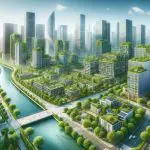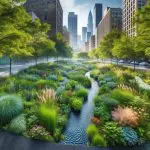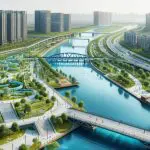
Explore how nature-based solutions for cities can transform urban living into greener, healthier spaces. Dive into innovative urban sustainability!
Nature-Based Solutions for Cities
Key Takeaways:
- Nature-based solutions for cities involve integrating natural elements like trees, parks, and green roofs into urban areas.
- These approaches enhance biodiversity, improve air quality, and mitigate climate change impacts.
- This leads to healthier, more sustainable, and resilient urban environments.
Welcome to the green revolution in urban planning! Discover how nature-based solutions for cities are redefining our concrete jungles into thriving ecosystems.
From rooftop gardens to lush urban parks, we’re uncovering the magic of blending nature with city living.
Join us on this exciting journey towards a greener, more sustainable future.
Introduction to Nature-Based Solutions in Urban Areas
As cities face increasing environmental and societal challenges, the importance of Nature-Based Solutions (NBS) in transforming urban landscapes into sustainable and resilient spaces is more evident than ever.
These innovative approaches offer a harmonious blend of human ingenuity and nature’s wisdom, promising a brighter future for urban living.
The Concept of NBS and Its Relevance in Modern Urban Planning
Nature-based solutions are grounded in the idea of using natural processes and elements to address various urban challenges.
This concept is not new but has gained significant traction in recent years due to its effectiveness and sustainability.
NBS encompasses a wide range of practices, from simple measures like planting trees to complex green infrastructure projects.
The underlying principle is to work with nature, rather than against it, to create healthier and more resilient urban environments.
Key aspects of NBS in urban planning include:
- Integration with Urban Design: Incorporating green elements like parks, green roofs, and walls into the urban fabric.
- Sustainability Focus: Prioritizing renewable resources and natural cycles to reduce environmental impact.
- Resilience Building: Enhancing the city’s ability to withstand and recover from environmental and climatic challenges.
Overview of the Global Trend Towards NBS in Cities
Globally, there’s a growing recognition of the benefits of integrating NBS into urban planning.
Cities across continents are adopting these solutions, driven by the urgency of climate change and the need for sustainable development.
This trend is evident in various initiatives, such as Europe’s Green Capital Award, which recognizes cities excelling in green urban living, and the increasing adoption of NBS in rapidly urbanizing countries in Asia and Africa.
Key global trends include:
- Increased Policy Focus: More local and national governments are framing policies to support NBS.
- Collaborative Efforts: Partnerships between governments, NGOs, and the private sector are emerging to promote NBS.
- Innovative Financing: New funding mechanisms are being explored to support these solutions.
Key Benefits: Ecosystem Services, Human Health, and Economic Development
The implementation of NBS brings multiple benefits, which are essential for the holistic development of urban areas:
- Ecosystem Services: NBS helps in restoring and preserving essential ecosystem services like air and water purification, flood control, and carbon sequestration.
- Human Health: By providing green spaces and cleaner air, NBS contributes significantly to improving the physical and mental health of urban residents.
- Economic Development: NBS can lead to job creation in green industries, increase property values, and reduce costs related to health care and environmental damage.
In a Nutshell:
In summary, Nature-Based Solutions represent a powerful tool in the quest for more sustainable and livable urban environments.
Their increasing adoption worldwide showcases a collective move towards urban development that respects and harnesses the power of nature for the betterment of human and ecological health.
Table: Overview of Nature-Based Solutions
| Aspect | Description |
|---|---|
| Concept | Utilizing natural processes to address urban challenges |
| Relevance | Increasing importance in sustainable urban planning |
| Global Trend | Growing adoption of NBS in cities worldwide |
| Key Benefits | Ecosystem services, human health, economic development |
Green Roofs: An Urban Solution for Sustainability and Biodiversity
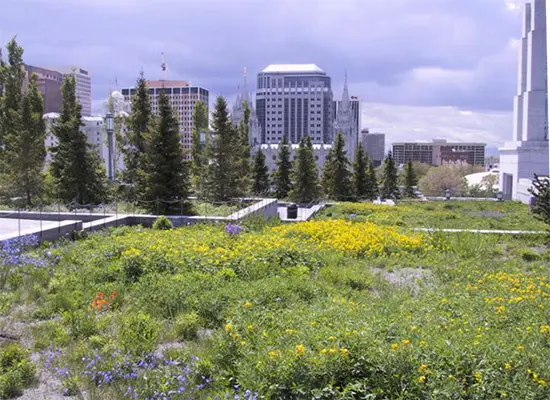
Green roofs, the practice of growing vegetation on rooftops, are becoming increasingly recognized as a vital element in urban sustainability and biodiversity enhancement.
These living roofs not only provide aesthetic appeal but also play a critical role in addressing environmental challenges in urban settings.
A green roof or living roof is a roof of a building that is partially or completely covered with vegetation and a growing medium, planted over a waterproofing membrane. It may also include additional layers such as a root barrier and drainage and irrigation systems. Wikipedia
How Green Roofs Contribute to Biodiversity and Climate Change Mitigation
Green roofs offer a unique opportunity for biodiversity conservation in urban areas, where natural habitats are often scarce.
They serve as mini-ecosystems, providing habitat for a variety of plants, insects, and birds.
This contributes to increased biodiversity, crucial for maintaining the ecological balance in urban areas.
Green roofs play a significant role in climate change mitigation:
- Temperature Regulation: They help reduce the urban heat island effect by absorbing heat and lowering temperatures on the roof surface and surrounding areas.
- Carbon Sequestration: Vegetation on green roofs absorbs carbon dioxide, helping to reduce greenhouse gas emissions.
- Stormwater Management: They absorb and filter rainwater, reducing runoff and improving water quality.
Case Studies of Successful Green Roof Implementations in Various Cities
Cities worldwide have implemented green roofs with notable success, showcasing their potential for urban sustainability.
- Toronto, Canada: Toronto’s Green Roof Bylaw mandates green roofs on all new commercial and residential buildings, significantly contributing to the city’s green infrastructure.
- Singapore: Known for its ‘City in a Garden‘ vision, Singapore has numerous green roofs that contribute to its biodiversity and sustainability goals.
- Chicago, USA: The city’s City Hall boasts an extensive green roof, which has become a model for other cities aiming to integrate nature into urban design.
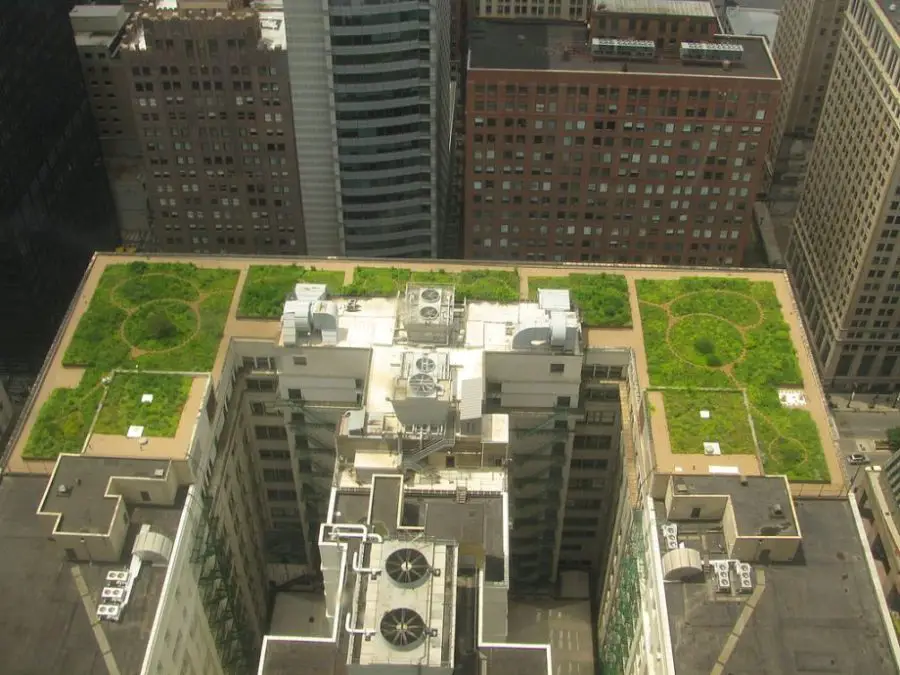
These examples demonstrate the adaptability of green roofs to different climates and urban contexts, showcasing their global applicability.
Challenges and Opportunities in Implementing Green Roofs
While green roofs offer numerous benefits, their implementation comes with challenges:
- Cost: The initial installation cost can be high, although long-term benefits often offset these costs.
- Maintenance: Regular maintenance is required to ensure the health and functionality of the vegetation.
- Structural Requirements: Buildings must be assessed for their ability to support the additional weight of a green roof.
Despite these challenges, the opportunities presented by green roofs are immense.
They offer a practical solution to urban environmental issues, enhance urban aesthetics, and provide social spaces for communities.
In a Nutshell:
Furthermore, with advancements in technology and growing environmental awareness, the future of green roofs in urban planning looks promising, paving the way for more sustainable, resilient, and biodiverse cities.
Table: Benefits and Challenges of Green Roofs
| Aspect | Benefits | Challenges |
|---|---|---|
| Biodiversity | Enhances urban wildlife habitats | Maintenance needs |
| Climate Change | Mitigates urban heat island effect, carbon sequestration | Structural requirements |
| Case Studies | Examples from cities like Toronto, Singapore, Chicago | Initial costs |
The Role of Local Governments in Promoting Urban Green Spaces
Local governments are pivotal in shaping the urban landscape, and their role in developing green spaces is crucial for sustainable urban living.
Green spaces not only beautify cities but also provide essential environmental, social, and health benefits, making them a key element in urban planning.
Strategies for Local Governments to Enhance Urban Green Spaces
Local governments can employ various strategies to increase and improve urban green spaces:
- Policy Development: Implementing policies that mandate green spaces in urban development plans.
- Community Engagement: Involving local communities in the planning and maintenance of green spaces.
- Funding and Resources: Allocating budget and resources for the development and upkeep of parks and green areas.
- Partnerships: Collaborating with the private sector, NGOs, and community groups to expand and manage green spaces.
- Innovative Design: Encouraging the use of innovative designs that integrate green spaces into urban infrastructure, such as green corridors and rooftop gardens.
The Impact of Green Spaces on Urban Resilience and Quality of Life
Urban green spaces significantly enhance the resilience and quality of life in cities:
- Environmental Benefits: They help combat the urban heat island effect, improve air quality, and support biodiversity.
- Flood Mitigation: Green spaces absorb rainwater, reducing flood risks.
- Health Benefits: Providing areas for physical activity and relaxation, green spaces contribute to the mental and physical well-being of residents.
- Social Cohesion: They act as communal areas that foster social interactions and community engagement.
Examples of Successful Urban Green Space Projects
Several cities around the world have successfully integrated green spaces into their urban fabric:
- New York City’s High Line: An elevated linear park built on a historic freight rail line, offering a green retreat amid the bustling city. Read more

- Singapore’s Gardens by the Bay: A futuristic park that blends urban life with nature, enhancing the city’s green footprint. More
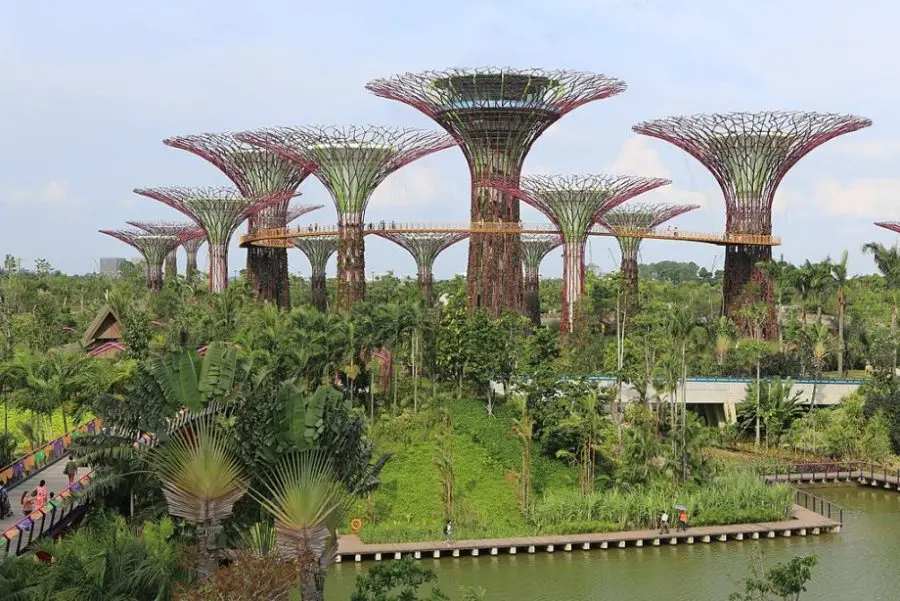
- Copenhagen’s Green Roofs: The city’s policy mandates green roofs in all new buildings, significantly increasing green space in the urban area. Read more
In a Nutshell:
These examples showcase the innovative ways local governments can incorporate green spaces into urban environments, enhancing the overall sustainability and livability of cities.
By prioritizing green spaces, local governments can play a transformative role in creating healthier, more resilient urban communities.
Table: Strategies for Enhancing Urban Green Spaces
| Strategy | Description |
|---|---|
| Policy Development | Implementing green space mandates in urban plans |
| Community Engagement | Involving residents in planning and maintenance |
| Funding & Resources | Allocating budget for development and upkeep |
| Innovative Design | Integrating green spaces in urban infrastructure |
Addressing Urban Challenges through Nature-Based Solutions
Nature-based solutions (NBS) offer innovative approaches to tackle some of the most pressing urban challenges.
By harnessing natural processes and ecosystems, NBS can significantly enhance urban environments, making cities more sustainable, resilient, and livable.
The Impact of NBS on Urban Heat Island Effect and Air Quality

NBS can play a crucial role in mitigating the urban heat island effect and improving air quality in cities:
- Temperature Regulation: Urban greenery, such as parks, green roofs, and street trees, can lower surface and air temperatures. Vegetation and soil in these green spaces absorb solar radiation and cool the air through evapotranspiration.
- Air Quality Improvement: Plants absorb pollutants and particulate matter, improving air quality. Urban forests and green belts are particularly effective in filtering out pollutants and providing cleaner air for residents.
Implementing NBS for temperature and air quality control not only makes cities more comfortable to live in but also contributes to public health benefits and energy savings.
NBS in Disaster Risk Reduction and Water Security
NBS is instrumental in enhancing a city’s resilience to natural disasters and in securing water resources:
- Flood Control: Natural landscaping, like wetlands and permeable pavements, can absorb excess rainwater, reducing the risk and severity of urban flooding.
- Water Quality and Security: Ecosystems such as forests and wetlands play a crucial role in water purification and regulation, ensuring a sustainable supply of clean water for urban populations.
- Coastal Resilience: Features like mangroves and coral reefs protect coastal cities from storm surges and erosion.
Incorporating these solutions into urban planning helps cities prepare for and respond to environmental shocks and stresses more effectively.
Integration of NBS in Sustainable Urban Development and Resilient Cities
Integrating NBS into urban development is key to building sustainable and resilient cities:
- Holistic Planning: Incorporating NBS into urban planning contributes to sustainable city designs that prioritize environmental health and resilience.
- Climate Change Adaptation: NBS can be tailored to address specific climate-related challenges faced by cities, such as extreme heat, rising sea levels, and increased precipitation.
- Social and Economic Benefits: Beyond environmental impacts, NBS can offer significant social and economic benefits, such as increased property values, health and well-being improvements, and job opportunities in green industries.
In a Nutshell:
By weaving NBS into the fabric of urban development, cities can create spaces that are not only environmentally sustainable but also socially and economically vibrant.
This integration is essential for the future of urban living, ensuring that cities remain habitable, resilient, and enjoyable for all residents.
Table: NBS Impact on Urban Challenges
| Urban Challenge | NBS Impact |
|---|---|
| Heat Island Effect | Temperature regulation through green spaces |
| Air Quality | Improvement by planting trees and vegetation |
| Disaster Risk | Natural buffers for flood control and coastal resilience |
| Water Security | Enhancing urban water cycles through natural methods |
Economic and Social Benefits of Nature-Based Solutions
Nature-based solutions (NBS) are not just a means to environmental sustainability; they also offer substantial economic and social benefits.
Implementing NBS in urban areas can lead to a more vibrant economy and cohesive society, making cities not only greener but also more prosperous and inclusive.
Economic Benefits: Job Creation, Economic Development, and Cost Savings
NBS contributes significantly to the economy in several ways:
- Job Creation: The development and maintenance of NBS, like urban parks and green roofs, create new jobs in various sectors, including construction, landscaping, and environmental management.
- Economic Development: NBS can boost local economies. For example, green spaces increase property values and can attract tourism and investment.
- Cost Savings: Investing in NBS can be more cost-effective in the long run compared to traditional infrastructure. For instance, natural flood mitigation methods are often cheaper and more sustainable than building levees or dams.
Social Impacts: Enhancing Social Cohesion and Human Well-being
The social benefits of NBS are equally important:
- Enhancing Social Cohesion: Green spaces are gathering places that foster community interaction and inclusiveness. They provide a sense of belonging and help build stronger communities.
- Improving Health and Well-being: Access to natural areas promotes physical activity, reduces stress, and improves mental health. Urban greenery has been linked to lower rates of depression and anxiety.
- Educational Opportunities: NBS offer educational benefits, especially for children, by providing hands-on learning about nature and sustainability.
The Role of the Private and Public Sector in Financing NBS
Financing NBS requires the involvement of both private and public sectors:
- Public Sector: Government funding is crucial for large-scale NBS projects. This can include direct investment, subsidies, and policy frameworks that encourage sustainable development.
- Private Sector: Private investments in NBS can be incentivized through tax breaks, public-private partnerships, and corporate social responsibility initiatives.
- Innovative Financing Models: Tools like green bonds, environmental impact bonds, and crowdfunding can also support NBS projects.
In a Nutshell:
By recognizing the multifaceted benefits of NBS, both economic and social, and leveraging the strengths of various sectors for funding, urban areas can transform into more sustainable, resilient, and equitable communities.
The economic growth and social enhancements brought by NBS underline their integral role in shaping the future of urban living.
Table: Economic and Social Impacts of NBS
| Impact Type | Economic Benefits | Social Benefits |
|---|---|---|
| Job Creation | New employment in construction, landscaping, etc. | Community Engagement |
| Economic Growth | Boost to local economies, increased property values | Health Improvements |
| Cost Savings | Long-term financial savings over traditional infrastructure | Educational Opportunities |
Case Studies: Successful Nature-Based Solutions in Cities
Exploring successful nature-based solutions (NBS) in different urban contexts provides valuable insights into their implementation and impact.
Here, we present a selection of case studies from around the world, highlighting the lessons learned and best practices, as well as the critical role of community engagement and local context.
Detailed Case Studies from Cities Around the World
- Melbourne, Australia – Urban Forest Strategy:
- Melbourne’s Urban Forest Strategy aims to increase its tree canopy cover to 40% by 2040. This initiative includes planting thousands of trees and increasing green space, which has led to improved air quality and urban cooling.
- Key Lesson: Long-term planning and setting measurable targets are crucial for successful urban forestry initiatives.
- Amsterdam, Netherlands – Rainproof Program:
- This program focuses on making the city resilient to cloudbursts and heavy rainfall. It includes green roofs, water storage, and permeable surfaces to manage stormwater effectively.
- Key Lesson: Integrating water management with urban design can effectively address flooding while enhancing the city’s aesthetic and ecological value.
- Curitiba, Brazil – Integrated Transportation and Green Spaces:
- Curitiba is known for its innovative urban planning, integrating transportation networks with green spaces. Parks and green belts along the transport routes have improved air quality and provided recreational areas.
- Key Lesson: Combining transportation planning with green space development can lead to more sustainable and livable urban environments.
Lessons Learned and Best Practices
These case studies demonstrate several best practices:
- Multi-functional Design: Effective NBS often serve multiple purposes, like improving air quality, providing recreational space, and managing stormwater.
- Community Involvement: Engaging the community in the planning and maintenance of NBS projects ensures their success and longevity.
- Adaptability: Tailoring NBS to the specific environmental and social contexts of each city is vital.
The Role of Community Engagement and Local Context in Successful Implementations
Community engagement is key to the success of NBS:
- Participatory Planning: Involving residents in the decision-making process ensures that the solutions meet the local needs and encourage community stewardship.
- Education and Awareness: Educating the public about the benefits of NBS increases support and participation.
- Local Context: Understanding the unique challenges and opportunities of each urban area helps in designing effective and sustainable NBS.
In a Nutshell:
These case studies highlight that effective implementation of NBS requires a combination of strategic planning, community involvement, and adaptability to local needs.
By learning from these examples, cities can develop more resilient, sustainable, and livable urban environments.
Table: Summary of Case Studies
| City | NBS Initiative | Key Lessons Learned |
|---|---|---|
| Melbourne, Australia | Urban Forest Strategy | Importance of measurable targets |
| Amsterdam, Netherlands | Rainproof Program | Integration of water management in urban design |
| Curitiba, Brazil | Integrated Transportation and Green Spaces | Combining green space with transportation planning |
FAQs: Understanding Nature-Based Solutions in Urban Areas
Nature-based solutions (NBS) in urban areas are gaining traction as effective means to enhance environmental sustainability, urban resilience, and community well-being.
However, their implementation raises several questions regarding their feasibility, effectiveness, and long-term sustainability.
This FAQ section aims to address common queries, providing insights into the practical aspects of NBS, their challenges, and the opportunities they offer for urban development.
Whether you’re a city planner, community member, or simply interested in sustainable urban living, these answers will shed light on how NBS can transform our cities for the better.
Q: What are the biggest challenges in implementing NBS in urban areas?
A: The primary challenges include funding constraints, lack of public awareness, and the need for interdisciplinary collaboration.
Urban planning often requires balancing various interests and integrating NBS can add complexity.
Additionally, adapting NBS to specific urban contexts and climates poses a significant challenge.
Q: How can local communities be involved in NBS projects?
A: Community involvement can take many forms, such as participatory planning sessions, volunteer opportunities in green space maintenance, and educational programs.
Local knowledge can be invaluable in designing effective NBS that resonate with the community’s needs and values.
Q: Are NBS cost-effective compared to traditional urban solutions?
A: Yes, in many cases. Although the initial investment for some NBS might be higher, they often lead to long-term cost savings by reducing expenses related to healthcare, energy, and environmental mitigation.
Additionally, NBS provides multiple benefits that traditional infrastructure might not offer, like biodiversity enhancement and improved mental health.
Q: How does NBS contribute to urban resilience?
A: NBS enhances urban resilience by providing natural buffers against climate impacts like flooding and heatwaves.
They also contribute to social resilience by improving public health and community cohesion, making cities more adaptable to changing environmental conditions.
Q: Can NBS positively impact mental health in urban populations?
A: Absolutely. Access to green spaces and natural environments in cities has been linked to reduced stress, lower anxiety levels, and overall improvements in mental well-being.
NBS like parks and green corridors provide essential opportunities for recreation and relaxation in urban settings.
Q: How can the long-term sustainability of NBS be ensured?
A: Long-term sustainability can be ensured through proper planning, regular maintenance, community stewardship, and adaptive management practices.
It’s also crucial to monitor and evaluate the performance of NBS over time to make necessary adjustments.
Q: What role do governments play in promoting NBS?
A: Governments are key in promoting NBS through policy development, funding, and setting regulatory frameworks.
They can incentivize NBS through subsidies, grants, and recognition programs, and play a vital role in facilitating partnerships between different sectors.
Conclusion: Embracing Nature-Based Solutions for Cities and Future Urban Landscapes
Nature-based Solutions to Climate Change (NBS) offers a promising pathway toward creating more sustainable, resilient, and livable cities.
This comprehensive exploration of NBS highlights their multifaceted benefits, from enhancing urban biodiversity and resilience to providing economic and social advantages.
As cities continue to evolve and face various challenges, NBS stands out as an innovative solution that can significantly improve urban life.
Harnessing the Power of Nature in Urban Development
- Integrating with Urban Fabric: NBS should be seamlessly integrated into urban planning and development to maximize its benefits.
- Balancing Development and Sustainability: Cities need to strike a balance between development and environmental sustainability, using NBS as a tool to achieve this equilibrium.
The Road Ahead for Nature-Based Urban Solutions
- Continued Innovation and Adaptation: Future urban planning must continue to innovate and adapt NBS to local contexts and emerging challenges.
- Expanding Community Involvement: Encouraging community participation in NBS projects ensures their success and longevity, fostering a sense of ownership and stewardship among residents.
- Strengthening Policy and Investment: Governments and private entities must continue to support and invest in NBS, recognizing their long-term benefits for urban environments.
Final Thoughts
The journey towards sustainable urban development is ongoing, and NBS represents a critical component in this quest.
By embracing these natural solutions, cities can not only address current environmental and social challenges but also pave the way for a healthier, more resilient future.
As we move forward, the continued exploration, implementation, and refinement of NBS will be essential in shaping cities that are not just habitable but also harmonious with nature.
In conclusion, the adoption of NBS is more than a trend; it’s a necessary shift in how we approach urban development.
As cities around the world continue to grow and evolve, the lessons learned and best practices shared through these studies will be invaluable in guiding this transformation.
The future of urban living looks brighter with the integration of nature at its core.
Resources Section: Further Reading and Information on Nature-Based Solutions
To delve deeper into the world of Nature-Based Solutions (NBS) in urban areas, the following resources offer extensive information, case studies, and insights:
- Urban Systems Lab: Provides a wealth of information on urban NBS, including research papers and articles on their implementation and impact in cities.
- Website: Urban Systems Lab
- International Union for Conservation of Nature (IUCN): Offers detailed insights into NBS, including guidelines, global standards, and case studies from around the world.
- Website: IUCN Nature-based Solutions
- United Nations Environment Programme (UNEP): Presents reports and articles on sustainable city planning and the role of NBS in addressing urban environmental challenges.
- Website: UNEP on Nature-based Solutions
- Edward Elgar Publishing – Nature-Based Solutions for Cities: An open-access book offering a comprehensive overview of NBS in various urban contexts, including chapters by leading experts.
- Website: Elgar Online
- World Wildlife Fund (WWF) – Urban Nature-based Solutions: Provides insights into how WWF supports the implementation of urban NBS for both people and nature.
- Website: WWF Urban Nature-based Solutions
- C40 Knowledge Community: Offers resources and articles on how cities can use nature to manage climate risks effectively.
- Website: C40 Knowledge Community
- Emerald Publishing – Nature-Based Solutions for More Sustainable Cities: Features chapters discussing design principles and sustainability assessments of urban infrastructures using NBS.
- Website: Emerald Insight
These resources provide valuable information for anyone interested in exploring the practical applications, benefits, and challenges of implementing NBS in urban environments. Whether for academic research, policy development, or general interest, these sources are excellent starting points for gaining a deeper understanding of how NBS can transform urban living.




